Have you ever heard of purslane? It's a small plant that you may have even enjoyed in a salad, but did you know that it is actually considered a lawn weed? Purslane has become a bit of a nuisance for many homeowners, appearing seemingly out of nowhere and spreading quickly. Simple Lawns has put together this blog post to go over all the details about purslane as a lawn weed, including its characteristics and best control methods. By the end of this read, you'll be well-equipped to tackle purslane head-on and get your lawn looking pristine once again. Let's dive in and learn more about this pesky little plant!
How To Identify Purslane

The first step in controlling purslane is being able to identify it. Purslane grows in the Virginia area and can be identified by its fleshy, succulent leaves and stems. These leaves are oval-shaped and thick, and both the leaves and stems may have a reddish hue in certain areas. In residential lawns, purslane typically grows somewhere between 4 and 8 inches tall, but it can grow as tall as 16 inches in ideal conditions.
Purslane is categorized as a broadleaf lawn weed because of its flat and wide leaves, but you can also identify this weed by the flowers it develops. Flowers of purslane are small and yellow, with 4 to 6 petals and 2 to 4 sepals growing underneath the petals. These flowers emerge singly in the middle of a cluster of leaves, and they will help you differentiate purslane from similar weeds. Spotted spurge, for example, is commonly misidentified as purslane due to its similar leaves and growth habits. However, the flowers of purslane look nothing like the tiny white or pink flowers of spotted spurge, and you can also look for purslane's relatively smooth stem and leaves compared to the hairier vegetation of spotted spurge.
Key Characteristics:
-Flat, oval-shaped leaves
-Thick, fleshy leaves and stems
-Leaves in clusters
-Reddish hue on stems
-Yellow flowers
-Dense, prostrate growth
Is Purslane Dangerous?
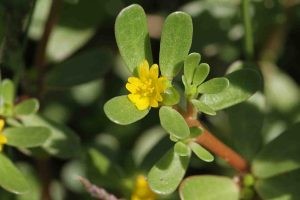
As you may already know, purslane is commonly used in salads and dishes across the world due to its nutritional benefits. All parts of purslane are edible for both humans and pets alike, so there is no health hazard to having purslane growing in your yard. Unfortunately, purslane is not nearly as beneficial to your grass!
Though it is an annual lawn weed, purslane develops a complex root system in its short life, which often invades and damages the roots of your grass. In addition to the roots, the way in which purslane grows above the soil is equally troubling for your lawn. Purslane's low, outward growth creates dense tangles and mats of vegetation across your lawn, which block out vital sunlight and suffocate the grass underneath. So, while purslane might be safe to have on your dinner plate, it is not something you want to allow to grow in your lawn.
When & Where Does Purslane Grow?
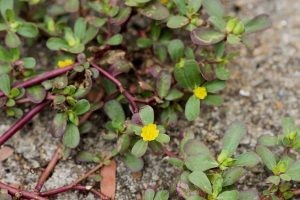
When: As a summer annual lawn weed, purslane loves the sunlight and high temperatures. Germination begins when soil temperatures reach at least 60 ℉, but the quickest germination takes place in temperatures closer to 85 ℉. Depending on the weather patterns and prevailing temperatures, you can typically expect to see purslane growing between late spring and late summer. Flowers develop within a month of germination, and seeds are produced within 3 weeks of flowering. Both flowers and new seeds will continue to be produced throughout the growing season, until temperatures become too cold for growth in fall, when the annual purslane will complete its life cycle.
Where: Purslane will be a continuous problem throughout summer if it is not dealt with promptly. It prefers dry and hot weather, but it is also very capable of competing for resources in well-irrigated soils. Though it grows in a variety of soil types, purslane prefers sandy soils that are rich in nutrients. Its waxy leaves make for a good natural defense against pests and fungi, which makes it able to grow in poorly performing lawns just as easily as it can grow in well-maintained lawns. It is also worth remembering that purslane is known to emerge in flower beds and gardens, so it is important to make sure you are checking every inch of your yard for this weed!
Will Purslane Spread?
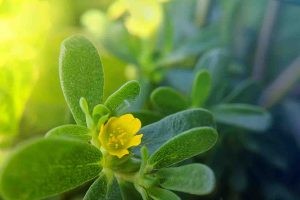
Common purslane spreads and grows at an aggressive rate, which is why it is such a formidable foe when it comes to weed control. In fact, purslane is one of the most difficult lawn weeds to eradicate once an invasion becomes widespread, which is due to purslane spreading by both seeds and roots. Though the weed spreads primarily by seeds, purslane has a central taproot and secondary fibrous roots that can regenerate if even a fragment of those roots is left in the soil.
In a single season, it is estimated that a large purslane plant can produce up to 240,000 seeds, and those seeds can remain viable in the soil for up to 40 years in ideal conditions. For these reasons, you should always expect a purslane invasion in your yard to be relentless and aggressive if you do not take the necessary steps to combat it!
How To Prevent & Control Purslane

Purslane will thrive in poor soil conditions, so keeping your lawn and yard in good health is the best way to prevent purslane. Since it is a low-growing weed, mowing your lawn at a height near 4 inches (or slightly above) is a great way to block sunlight from reaching young purslane. Direct sunlight is key for purslane as it tries to grow, so blocking that light is crucial. Mulching the soil around your gardens and flower beds is also a great way to block light from reaching any young seedlings trying to emerge in your yard.
Removing purslane is a bit more tricky, but there are ways to effectively eradicate an invasion that has already begun. As an annual plant, purslane does not develop a very deep central taproot like those of many perennial lawn weeds. This means that pulling the weed up from the roots is possible, but you do have to make sure that no fragments are left in the soil from which new growth will emerge. Keep the following tips in mind if you try to remove purslane from your yard this summer:
-Start Early: Stay vigilant, and remove purslane when it is immature (before it flowers) to avoid spreading seeds.
-Remove Everything: Both the stems above ground and the roots below can spawn new growth, so get it all!
-Use Tools: A gardening spade or shovel is strongly advised to assist you with a more effective removal of purslane.
-Do Not Compost: Reintroducing composted purslane will also lead to new growth from the remaining fragments.
-Bag Removed Weeds: Containing any removed plant matter is a good way to ensure seeds can't disperse.
-Apply Chemicals: Spraying seedlings with 2, 4-D and applying pre-emergent in spring are the most effective ways to control purslane. Call Simple Lawns today for all your weed control needs in the Portland area!
Subscribe to Simple Lawns's Blog




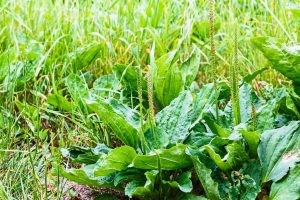

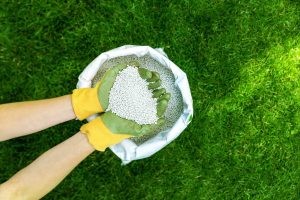

Comments